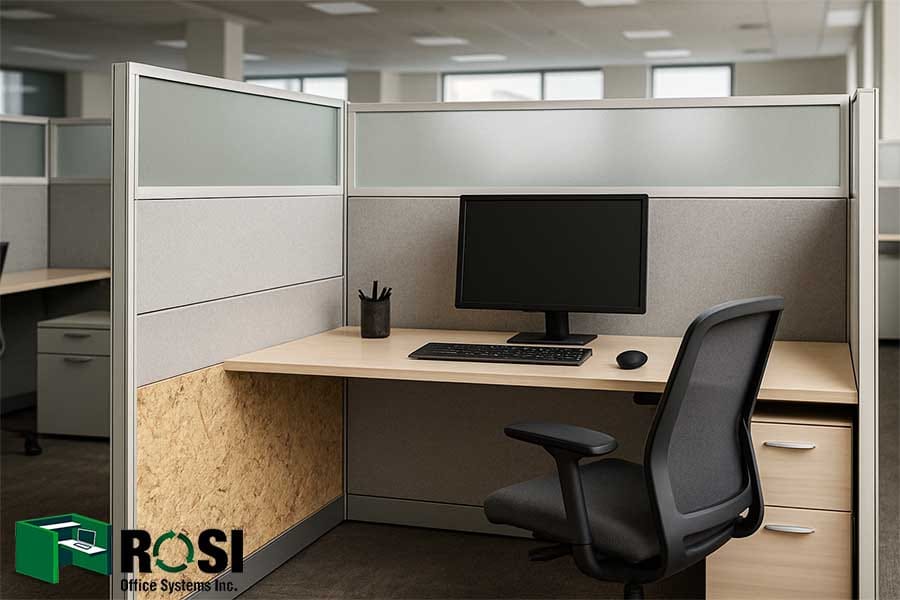
If the question on your mind is, “What are office cubicles made of in 2025?”
In response, we must say that: In 2025, office cubicles are commonly made of recycled metals and plastics, sustainable bamboo and wood for structure, as well as advanced materials like acoustic foams and fabrics to absorb sound. Cubicle surfaces will often be smart, with wireless chargers and USB ports. Designs will move toward modularity to allow for easy adjustment and relocation.
With the widespread changes that have occurred in the way we work, office design, and environmental concerns, the materials used in workspace design have also transformed.
In general, in 2025, office cubicles for sale will be built with a focus on sustainability, technology, and employee well-being.
In this article, we will take a full look at exactly what materials office cubicles will be made of in 2025.
This guide will help you make the best decision in choosing the right material for your needs today and in the future.
Let’s see what materials office cubicles will be made of in 2025.
Core Structural Materials
One of the most important parts of any office cubicle, as commercial office furniture, is its internal structure, or skeleton.
This structure can determine the strength, stability, and longevity of the entire office cubicle.
In 2025, the use of durable yet lightweight materials for the internal skeleton has become a standard in modern office design.
- Metal framing: Usually, the internal skeleton of office cubicles is made of steel or aluminum.
The main reason for using these metals is their high durability, resistance to bending and corrosion, and ease of installation.
Due to its high strength and durability, steel is suitable for cubicles that require greater durability and resistance and are used in high-traffic spaces or large office environments.
In contrast, aluminum is more commonly used in portable, modular, and modern office cubicles due to its lighter weight and acceptable strength.
- Frame finishes: After the metal frame is constructed, its surface is usually covered with some kind of final coating (finish) to both improve its appearance and make it more resistant to environmental damage.
One of the most common coating methods in 2025 is powder coating.
This type of coating is very resistant, uniform, and long-lasting, and performs better than traditional paints against scratching or peeling.
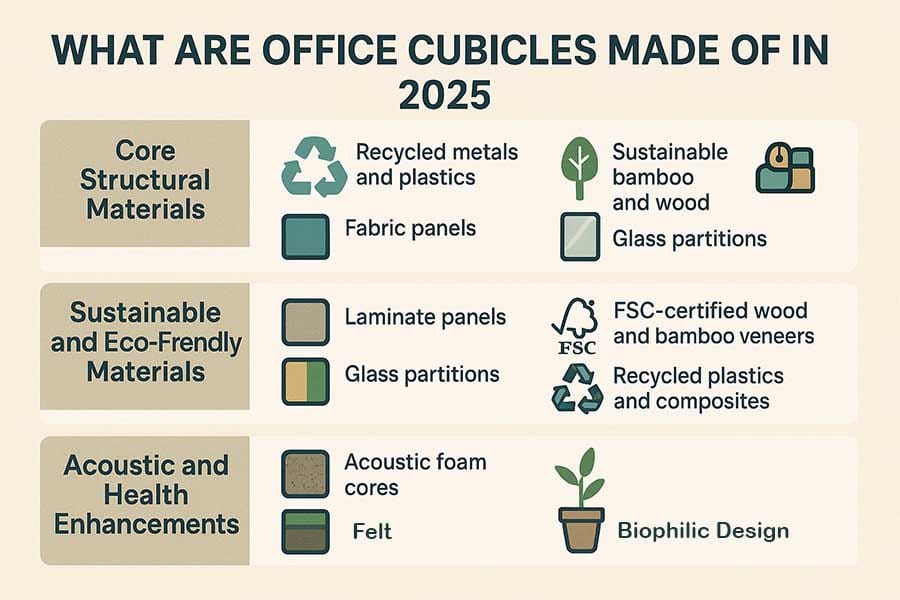
You Might Also Enjoy: What Are the Most Effective Acoustic Panels for Office Cubicles?
Panel Types and Coverings
The main panels or walls of the cubicles are the part that determines the overall appearance, the level of soundproofing, and even the sense of space.
In 2025, the variety of panel materials and designs will increase dramatically, combining functionality, aesthetics, and environmental sustainability.
- Fabric panels: Fabric panels are one of the most commonly used types of panels in office cubicles.
These panels usually consist of an inner core such as fiberboard or compressed foam, which is covered with a special fabric.
The fabrics used in these panels are usually soundproof and help improve the acoustics of the environment.
- Laminate panels: Laminate panels are very popular in offices due to their ease of cleaning, high resistance, and modern appearance.
These panels consist of an inner core, often MDF or compressed wood, with the surface covered with a high-pressure laminate (HPL) or wood laminate.
Laminates are highly resistant to scratches, moisture, and stains, making them an ideal choice for high-traffic spaces.
- Glass partitions: Glass partitions in 2025 are a popular option for spaces that require natural light, transparency, and a sense of openness, while also maintaining privacy.
These glasses of private office cubicles may be clear, frosted, or patterned.
In modern offices of 2025, the use of frosted glass to separate spaces without interrupting visual communication has become very common.
It is also possible to print custom logos or patterns on the glass, which, in addition to being beautiful, contributes to the brand’s visual identity.
Glass is also a hygienic and disinfectable surface, making it ideal for professional spaces or high-traffic offices.
- Mixed media: In 2025, many designers and manufacturing companies have moved towards using multi-material or composite panels.
These panels are made from a combination of materials such as fabric, glass, laminate, natural wood, wood veneer, or even recycled materials.
This type of design not only creates a modern and creative look, but also allows for optimization of performance, such as sound insulation along with natural light.
The combination of materials allows users to tailor the design of the workspace to their functional and aesthetic needs.
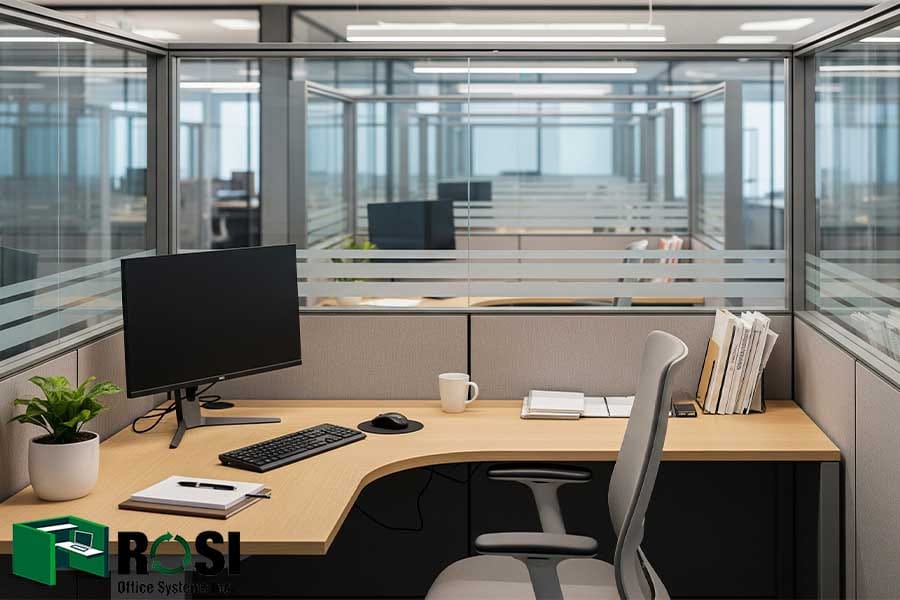
You Might Also Enjoy: What Are the Most Durable Office Cubicles for Small Businesses?
Sustainable and Eco‑Friendly Materials
With increasing awareness of climate change and corporate social responsibility, the use of sustainable materials in the design and construction of office spaces has become a major priority in 2025.
Today, modern office cubicles are no longer built solely based on functionality, but serious attention is also paid to environmental impact and recyclability in the selection of their materials.
- Recycled metal and plastics: One of the most effective solutions to reduce environmental pollution is to use recycled materials in the manufacture of cubicle components.
Many manufacturers will use recycled steel and aluminum to make the main skeleton of cubicles in 2025.
After recycling, these metals have the same quality and durability as their original versions, but are produced with a smaller carbon footprint.
Additionally, recycled plastics are also used in peripheral components such as covers, edges, and connectors.
- FSC‑certified wood and bamboo veneers: In line with Biophilic Design, which emphasizes the return of human connection to nature in workspaces, the use of FSC-certified wood and bamboo veneers has become increasingly popular.
FSC (Forest Stewardship Council) certification guarantees that the wood used has been harvested from sustainably managed forests, without harming the ecosystem.
Bamboo is also considered a great alternative to solid woods due to its fast growth, high durability, and natural appearance.
- Recycled plastics and composites: One of the newest trends in office cubicle design in 2025 is the use of modular structures made from recycled plastics and innovative composite materials.
Architectural and engineering research has shown that these types of structures, such as plastic chainmail structures, are lightweight, highly flexible, and easy to rearrange.
These materials are often made from recycled polymers and can be put together in modular pieces to create changeable and flexible workspaces.
Acoustic and Health Enhancements
In modern workplaces, psychological comfort, mental health, and stress reduction have become the main criteria in designing office spaces, in addition to appearance.
One common problem in open offices is noise pollution and lack of acoustic privacy, which can reduce employee focus and affect productivity.
For this reason, in the construction of 2025 office cubicles, special attention has been paid to acoustic characteristics and elements affecting environmental health.
- Acoustic foam cores and felt: Many modern office cubicles are made with sound-absorbing foam built into their panels.
These foams are specifically designed to absorb sound waves and prevent sound reflections in the workspace.
The use of felt, either as an external covering for panels or as part of the internal structure, has also become very common.
Felt is a natural and flexible material that, in addition to its high acoustic properties, adds a warm and cozy texture to the space and creates a greater sense of comfort.
- Design trends: In 2025, the approach to designing workspaces has shifted towards creating environments with a positive psychological impact and connection to nature.
One of these trends is the use of felt coverings, lino, and plants integrated into the structure of partitions.
Indoor pots, green shelves, or even living walls are part of this approach that transforms the workspace from a boring one into a relaxing and energetic environment.
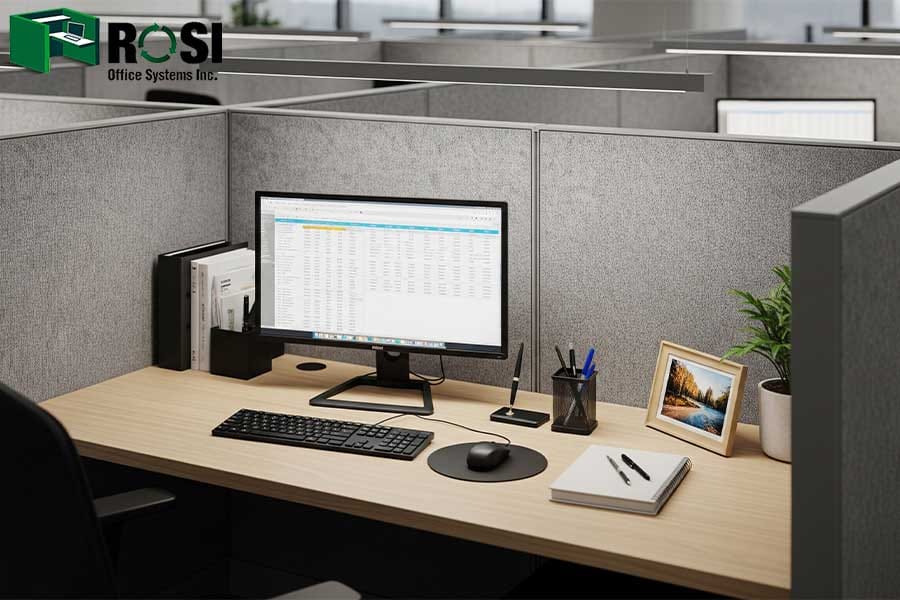
You Might Also Enjoy: Where to Buy Office Cubicles: Top 10 Places in 2025
Technology and Smart Integration
With the advancement of technology and the growing need for flexible and digital workspaces, office cubicles have also become part of a smart and dynamic system.
In 2025, the use of technological solutions in the design and construction of office cubicles has become a competitive advantage for modern offices.
- Cable management and power/data channels: One of the biggest challenges in office design is managing cables, wires, and access to power and data sources.
In 2025, many high-end office cubicles are designed with hidden channels for cables, power cords, and data ports built into the core of the panels.
This feature ensures that the workspace is always tidy, safe, and clutter-free, and that employees have quick and easy access to electricity and the internet.
- Smart partitions or mobile robotic walls: One of the most futuristic trends in office design in 2025 is smart office cubicles and movable walls with automatic control capabilities.
These systems can be configured to open or close the workspace, create privacy, or transform the space for meetings and group collaboration, depending on the need.
- Integrated lighting or sensor options: Another feature of modern office cubicles is the integration of lighting and built-in sensors into their structure.
In many advanced designs, LED task lighting is built directly into the cubicle body or office desk surface.
Some office cubicles also have motion, ambient light, or temperature sensors that can be connected to smart energy management or air conditioning systems.
Trending Cubicle Components
In 2025, cubicles have evolved into complete, multi-purpose systems that utilize a variety of components for better functionality, greater comfort, and modern design.
Together, these components provide the user with a professional, organized, and personalized experience in the workplace.
- Work surfaces and desktops: In most cases, the work surface of office cubicles is made of engineered wood such as MDF or plywood, which is resistant to pressure and weight.
To create a beautiful, durable, and comfortable surface, laminate or natural wood veneer is used on this wooden core.
In 2025, many brands will allow you to choose the color and design of these surfaces to coordinate with the overall office decor.
- Overhead bins, shelving, pedestals: To optimize storage space, most modern office cubicles are equipped with components such as overhead bins, open shelving, and pedestals.
These components are usually made from a combination of metal, laminated MDF, and durable plastic.
This material combination makes the components lightweight, durable, and coordinated with the panels and table.
- Trim and connectors: Seemingly small but very important components in office cubicle design are trims and connectors, which are used both to connect panels together and for the final aesthetic.
These components are often made of durable PVC plastic or anodized aluminum.
Trims and connectors help create a clean, safe, and harmonious appearance within the overall structure of the office cubicle.
How to Select Materials for Cubicles in 2025?
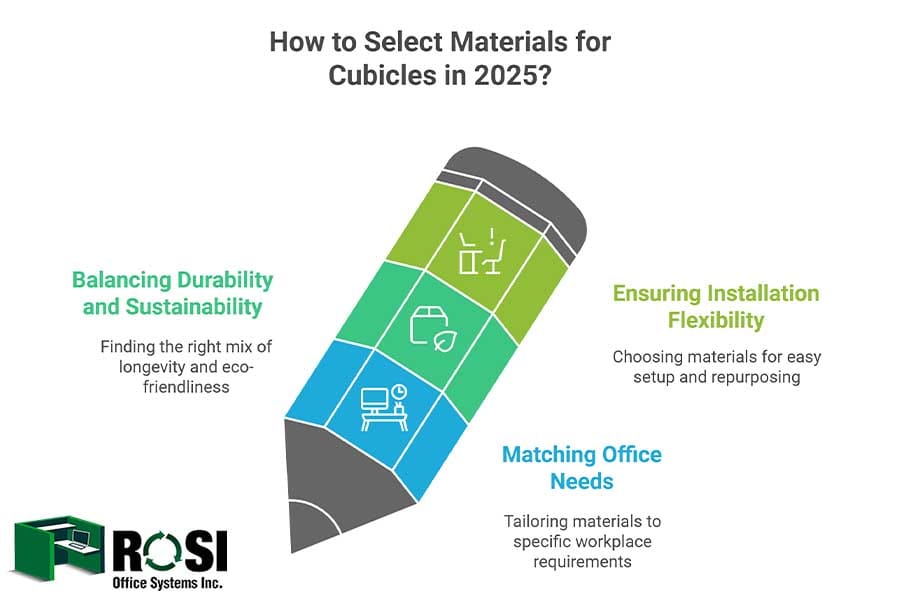
You Might Also Enjoy: How to Disassemble Office Cubicles in 30 Minutes?
In selecting the right material for office cubicles in 2025, a combination of functional, environmental, and human factors plays a role in the final decision.
- Match Materials to Office Needs: The first step is to assess the real needs of your workspace.
Does your environment require audio and visual privacy?
So you should use sound-absorbing fabric panels or frosted glass partitions.
Is using natural light a priority?
In this case, translucent glass or shorter partitions are a better option.
Also, if your focus is on environmental sustainability, go for FSC-certified wood, recycled aluminum, or bamboo veneers.
- Evaluate Durability vs. Eco Credentials: One of the design challenges in 2025 is to strike a balance between durability and environmental sustainability.
Some materials, such as metal or glass, are very durable but may be less sustainable.
In contrast, materials like recycled plastics or bamboo are more environmentally friendly but may be less resistant to impact or abrasion.
- Consider Installation Flexibility and Future Repurposing: In the ever-changing workplace of the future, it is important to choose materials that can be installed quickly, moved easily, and reused in the future.
Modular systems with lightweight frames or portable panels allow companies to redesign their workspace as teams grow or structure changes, without having to purchase new equipment.
Conclusion
Looking at the trends in the formation of workspaces, it is clear that the materials used in office cubicles in 2025 will serve mental health, environmental sustainability, functional flexibility, and integration with new technologies.
Materials such as sustainable woods, recycled metals, acoustic panels, translucent partitions, and smart modular structures all represent a fundamental shift in how office cubicles are designed and built.
In this article, we talked about what materials office cubicles will be made of in 2025 to help you choose the best options.
Today, decisions about the materials used in office cubicles must align with the values of the modern workforce: environmental sustainability, increased productivity, psychological well-being, and compatibility with a hybrid work style.
Choosing the right material means investing in the quality of life and work of your business tomorrow.

John Ofield is a recognized expert in the office furniture and office cubicle industry in Houston, TX, with over 40 years of experience. As the founder of ROSI Office Systems, he specializes in furniture space planning, custom cubicle designs, modern office chairs and tables, and high-quality commercial furniture. John’s expertise helps businesses enhance productivity and collaboration. He is also dedicated to mentoring entrepreneurs and redefining workspaces to inspire success.